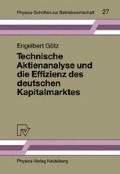Zusammenfassung
Ein Ereignis, wie die weltweite Börsenkrise am 19. Oktober des Jahres 1987, zeigt in aller Deutlichkeit die Aktualität der Diskussion, die über die These der rationalen Erwartungen im Wirtschaftsprozeß einer Volkswirtschaft geführt wird.1)
Access this chapter
Tax calculation will be finalised at checkout
Purchases are for personal use only
Preview
Unable to display preview. Download preview PDF.
Literatur
Vgl. ARBEL, A., CARVELL, S., POSTNIEKS, E., The Smart Crash of October 19th, in: Harvard Business Review, 66 (3/1988), S. 124–136;
BARATTA, J., WUMMEL, D., Der 19. Oktober 1987, Terminmärkte, Programm-Handel und Portfolio-Versicherung, in: Die Bank, 28(1988), S. 141–149;
PATERSON, R., The efficient Market: An Alternative View, in: The Accountant’s Magazine, 92(1988), No. 980, S. 25
ISSING, O., Rationale Erwartungen — im Jahre 67 vor Christus, in: Kyklos, 38(1985), S. 104–105
Vgl. CICERO, M. T., Sämtliche Reden, eingeleitet, übersetzt und erläutert von FUHRMANN, M., Bd. I, Zürich 1970, S. 323 ff, zitiert nach ISSING, O., Rationale Erwartungen — ..., S. 105
Vgl. CICERO, M. T., Sämtliche Reden ..., S. 348 (Hervorhebung im Original)
An anderer Stelle berichtet allerdings CICERO, daß der Zinssatz an einem einzigen Tag von 4 auf 8% gestiegen ist — und das aufgrund der Nachricht über eine Vereinbarung, die den Einsatz immenser Summen im Wahlkampf vorsah; ein weiteres Beispiel zur Historie rationaler Erwartungen. ISSING, O., Eigennutz und Politikerverhalten, in: HANUSCH, H., ROSKAMP, K.W., WISEMANN, J. (Hrsg.), Staat und politische Ökonomie heute, Horst Claus RECKTENWALD zum 65. Geburtstag, Stuttgart 1985, S. 27
ISSING, O., Rationale Erwartungen — im Jahre 67 vor Christus, in: Kyklos, 38(1985), S. 105
Vgl. FAMA, E. F., Efficient Capital Markets: A Review of Theory and Empirical Work, in: JoF, 25(1970), S. 383–417
Vgl. NEUMANN, M. J.M., KLEIN, M., Probleme der Theorie effizienter Märkte und ihrer empirischen Überprüfung, in: KuK, 15(1982), S. 165–187
Vgl. FAMA, E. F., Efficient Capital Markets .... S. 384 f
Vgl. LEROY, S. F., Efficient Capital Markets: Comment, in: JoF, 31(1976), S. 139 f
Vgl. FAMA, E. F., Reply, in: JoF, 31(1976), S. 143–145
Vgl. COPELAND, T. E., WESTON, J. f., Financial Theory and Corporate Policy, 2. Aufl., Reading (Mass.) et al. 1983, S. 318
Vgl. MUTH, J. F., Rational Expectations and the Theory of Price Movements, in: Econometrica, 29(1961), S. 315–335
Vgl. FRIEND, I., BLUME, M., Measurement of Portfolio Performance under Uncertainty, in: AER, 60(1970), S. 561–575
Vgl. ROLL, R. A., Critique of the Asset Pricing Theory’s Test’s, Part I: On Test and Potential Testability of the Theory, in: JFE, 4(1977), S. 129–176
Vgl. FRIEND, I., BLUME, M., Measurement of Portfolio .... S. 561–575
Verwendet wurde die SPSS-X Programmversion 2.2, die auf den Rechenanlagen HP 3000/48 und IBM 9370–090 des Rechenzentrums der Universität Passau implementiert ist.
Vgl. zur Verdeutlichung Anhang 5
Vgl. LERBINGER, P., Aktienkursprognose durch Linienchart-Formationen und Trendlinien, München 1984
Vgl. LERBINGER, P., Aktienkursprognose und Linienchart-Formationen und Trendlinien, in: AG, 33(1988), S. 10
Lediglich die Branchenzugehörigkeit wird als diskrete Variable (= Dummy-Variable) verwendet (vgl. LERBINGER, P., Aktienkursprognose durch Linienchart-Formationen ... (1988), S. 14)
Vgl. LEVY, R. A., The Relative Strength Concept of Common Stock Price Forecasting, Larchmont (N. Y.) 1968
Bei zwei dieser Kennzahlen handelt es sich um selbstkonstruierte Indikatoren, die somit nicht dem Vorwurf der “self-fulfilling prophecy” von technischen und fundamentalen Merkmalen ausgesetzt sind, die von sehr vielen Marktteilnehmern rezipiert und für bedeutsam gehalten werden.
Author information
Authors and Affiliations
Rights and permissions
Copyright information
© 1990 Physica-Verlag Heidelberg
About this chapter
Cite this chapter
Götz, E. (1990). Einleitung. In: Technische Aktienanalyse und die Effizienz des deutschen Kapitalmarktes. Physica-Schriften zur Betriebswirtschaft, vol 27. Physica-Verlag HD. https://doi.org/10.1007/978-3-642-52387-8_1
Download citation
DOI: https://doi.org/10.1007/978-3-642-52387-8_1
Publisher Name: Physica-Verlag HD
Print ISBN: 978-3-7908-0455-3
Online ISBN: 978-3-642-52387-8
eBook Packages: Springer Book Archive

